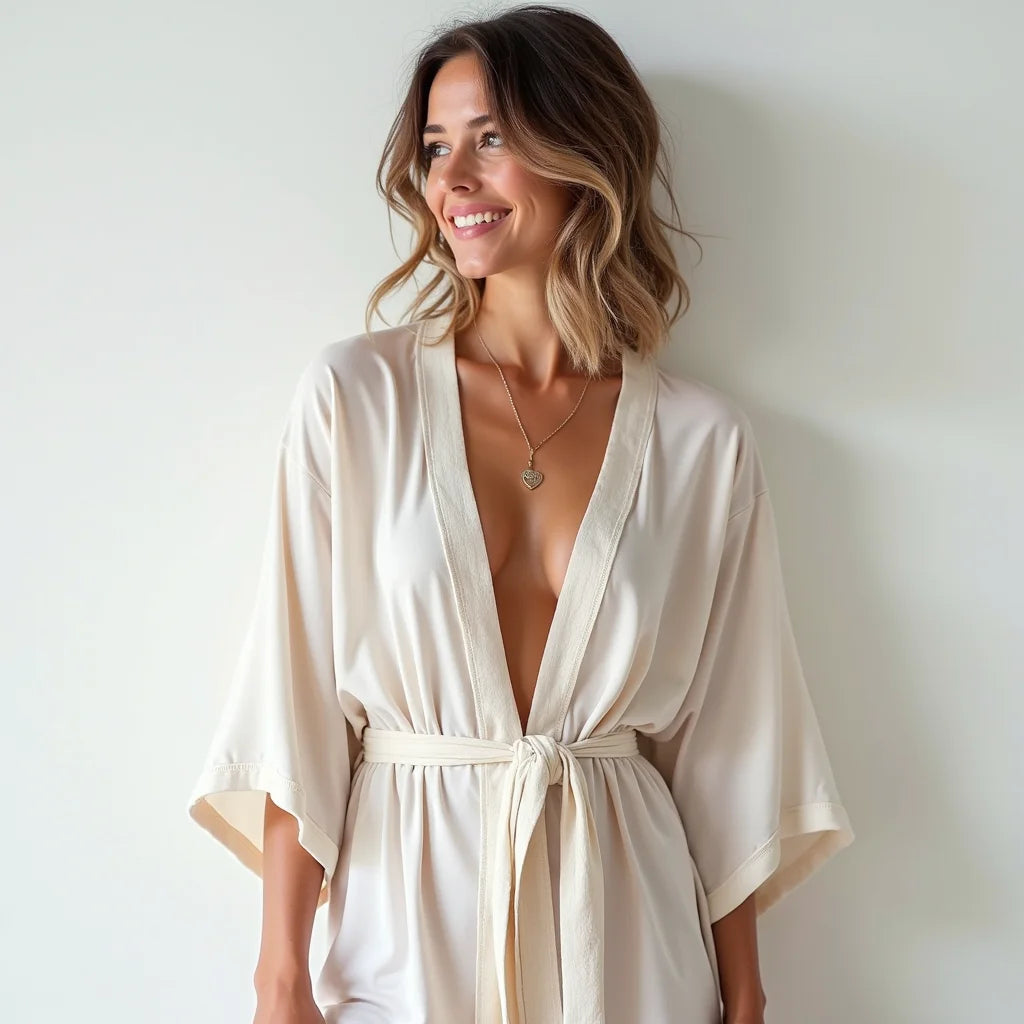
Beach Kimono Cover Ups Decoded for Versatile Styling
Share
Updated on: 2025-10-27
Table of contents for beach kimono cover ups
- A thoughtful introduction to the beach kimono cover up
- Beach kimono cover up myths vs facts
- Step-by-step guide: how to choose and style a beach kimono cover up
- Frequently asked questions about beach kimono cover ups
- Summary and key takeaways on beach kimono cover ups
- Community Q&A on the beach kimono cover up
- About Iyanka — styling advice for beach kimono cover ups
A thoughtful introduction to the beach kimono cover up
A beach kimono cover up is a simple way to feel comfortable between swims, during lunch by the shore, or on a gentle walk at sunset. Whether you prefer a breezy kimono beach cover-up or a slightly structured kimono swimsuit cover up, the right layer can provide coverage while keeping movement light. Many designs blend function and expression, from a lightweight chiffon beach kimono cover up for women to a plus size floral beach kimono cover up with tassels. In this guide, you will find calm, clear advice to help you choose a cover-up that suits your style, your plans, and the weather.
Beyond the sand, this versatile layer pairs well with everyday pieces. Worn open, a boho kimono cardigan can add color and flow to a tank and jeans, or soften the lines of a fitted dress. With a few careful choices, your cover-up can serve as a gentle, go-anywhere layer you reach for often.
Beach kimono cover up myths vs facts
-
Myth: A beach kimono cover up is only for the beach.
Fact: It transitions well to casual settings. You may wear it over a slip dress, shorts and a tee, or athleisure. -
Myth: Only one fabric works for cover-ups.
Fact: Different fabrics suit different needs. Chiffon is airy, rayon drapes softly, and cotton blends add breathability. Each has a place depending on climate and preference. -
Myth: Long kimonos overwhelm petite frames.
Fact: The right proportion and side slits can elongate the line. A knee-length or mid-calf cut can be very flattering. -
Myth: Prints are hard to style.
Fact: Repeating one color from your swimsuit or accessories can tie the look together with ease. -
Myth: One size fits all covers every body type.
Fact: While many kimonos are relaxed, shoulder width, sleeve length, and side openings vary. Checking measurements helps ensure comfortable movement.
Step-by-step guide: how to choose and style a beach kimono cover up
This step-by-step plan offers a calm path to a comfortable, confident choice. It blends fit, fabric, and styling ideas so your beach kimono cover up feels effortless in many settings.
Step 1: Choose the right material
If you enjoy floaty movement and quick drying, chiffon can be a kind option. A lightweight chiffon beach kimono cover up for women feels airy in warm weather and packs small. Rayon drapes with a soft hand, which may feel soothing on skin. Cotton and cotton blends add breathability and a gentle matte finish that works from beach to brunch. If you prefer structure, a slightly denser weave provides a clean line in wind. Whichever you choose, hold the fabric up to the light if possible and consider how sheer you want it to be.
Step 2: Find your fit and length
Fit is personal. Many people enjoy a relaxed shoulder and a straight line that skims the body. If you value extra coverage, you might try a mid-calf length with modest side slits for easy steps on sand. A plus size floral beach kimono cover up with tassels can offer beautiful movement and balanced weight at the hem. Sleeves that hit near the elbow tend to feel practical while still airy. If you prefer more definition, a soft tie at the waist can create shape without adding bulk.
Step 3: Pick colors and prints
Consider the swimsuits you reach for most. Choosing a kimono that shares a color with your swim top or bottoms brings harmony to the look. If you love bold prints, a kimono beach cover-up with botanical or abstract motifs can be expressive. If you prefer calm tones, a soft neutral or pastel feels easy to repeat across outfits. Tassels or subtle trims can add friendly detail without feeling busy.
Step 4: Style for the beach and beyond
At the shore, many people wear their beach kimono cover up open over a suit. For a bit more coverage, tying a gentle knot at the hem adds shape and helps in breezy weather. When you head away from the water, a kimono swimsuit cover up can become a light layer over a fitted tank and linen shorts, a tee dress, or even athleisure. A boho kimono cardigan style can soften denim or add movement to a simple monochrome outfit. Pair it with minimal jewelry and comfortable sandals for an easy finish.
If you would like to explore swim options to pair with your kimono, you may find inspiration in Bikinis. For a wider browse of outfits you can layer under your cover-up, you might enjoy visiting All collections or the broader Collections page. A light kimono also layers nicely over casual dresses such as those in A-line dress silhouettes.
Step 5: Care and packing tips
- Read the care tag and follow the gentlest method advised for the fabric.
- Hand wash or use a delicate cycle and a laundry bag to reduce friction.
- Air dry flat or on a padded hanger to preserve shape and trims like tassels.
- For travel, roll rather than fold to reduce creases. Place in a breathable pouch.
- Spot clean salt or sunscreen gently to keep the fabric looking fresh.
Frequently asked questions about beach kimono cover ups
What material is best for a beach kimono cover up?
The best material depends on your climate and comfort. Chiffon is ultra-light and quick to dry, rayon offers a soft drape, and cotton blends provide breathability with a gentle matte look. If you value the most airflow, choose chiffon or a loose-weave cotton. If you prefer a little structure that still feels easy, rayon or a slightly denser blend can be reassuring.
How do you style a beach kimono cover up beyond the beach?
Wear it open over a tank and jeans, a slip dress, or an athleisure set for a relaxed, flowing layer. A boho kimono cardigan works well with neutral basics and simple sandals. Repeating one color from your kimono in your top, bag, or shoes ties the look together in a soft, cohesive way.
How should a kimono swimsuit cover up fit?
Look for a relaxed shoulder, comfortable sleeve length, and enough room to move easily. The hem can hit at the knee, mid-calf, or ankle depending on your preference. If you want a tidy shape, a gentle waist tie or a partial front tuck can add definition without losing ease.
Summary and key takeaways on beach kimono cover ups
A beach kimono cover up offers comfort, coverage, and calm style. Fabric choice shapes the experience: chiffon for lightness, rayon for drape, cotton blends for breathability. Fit and length help with ease of movement, while prints and trims add personality. Your kimono can serve on the sand and beyond, working as a light layer over many everyday outfits. With simple care, it will remain a trusted piece in your wardrobe.
If you feel ready to explore options, browsing a few curated pages may be helpful. You can start with a wide view in All collections or explore swim pairings in Bikinis. When you are styling for daily wear, an A-line dress can be a lovely base layer under your kimono, and you can find ideas in A-line dress. For a larger catalog of categories, Collections provides a gentle overview.
Community Q&A on the beach kimono cover up
Can a beach kimono cover up replace a cardigan on cooler evenings?
It can, with a few considerations. On mildly cool evenings, a mid-weight rayon or cotton blend kimono adds a light barrier. For cooler temperatures, you may prefer to layer it over a long-sleeve top to maintain warmth while keeping the flow and color you enjoy.
Is a beach kimono cover up appropriate for a casual restaurant near the shore?
In many casual settings, yes. Worn over a simple tank dress or coordinated top and shorts, it creates a relaxed, presentable outfit. Choosing a style with modest coverage and a neat hem helps it feel suitable when stepping indoors.
What is the difference between a beach kimono cover up and a sarong?
A sarong is typically a wrap of fabric tied around the waist or torso. A beach kimono cover up is usually a sewn garment with sleeves or open sides that you slip on. The kimono offers more coverage and can be easier to wear while walking or dining.
Will tassels or trims feel heavy when wet?
Some trims absorb water more than others. If you plan to wear your kimono very close to the waterline, you may prefer lightweight tassels or minimal trim. If trims are important to you, look for shorter, denser tassels that keep their shape.
How many beach kimono cover ups does a versatile wardrobe need?
One well-chosen piece can serve often. If you like variety, a neutral kimono for frequent wear and a printed option for expressive days can cover many moments with ease.
About Iyanka — styling advice for beach kimono cover ups
About the author
Iyanka is a friendly stylist and attentive editor who enjoys helping readers find comfort and ease in everyday outfits, including the beach kimono cover up and related layers. With a calm, practical approach to materials, fit, and care, Iyanka shares accessible style tips for real days and real wardrobes. Thank you for spending a moment here — wishing you many relaxed steps by the water and beyond.
The content in this blog post is intended for general information purposes only. It should not be considered as professional, medical, or legal advice. For specific guidance related to your situation, please consult a qualified professional. The store does not assume responsibility for any decisions made based on this information.
